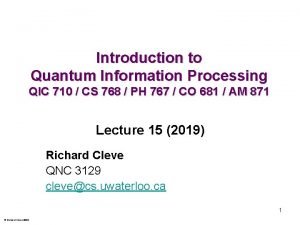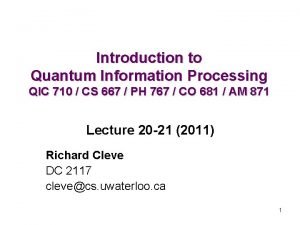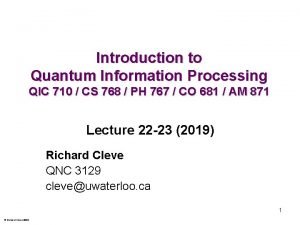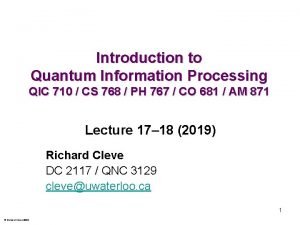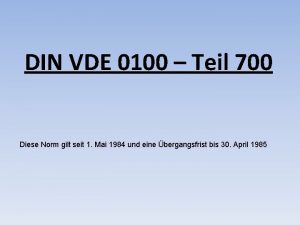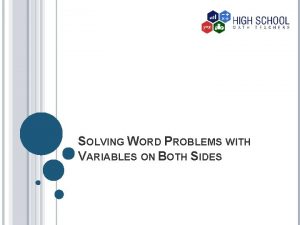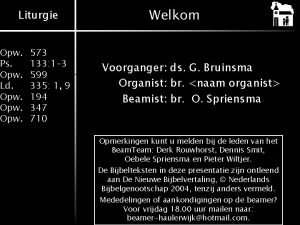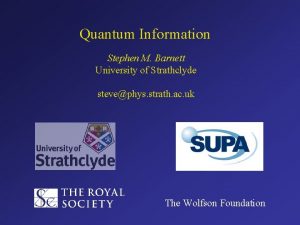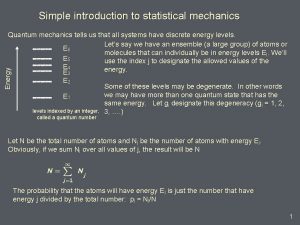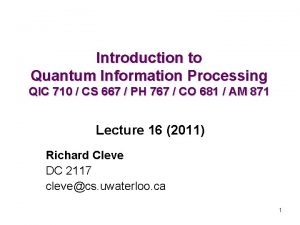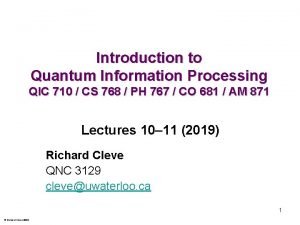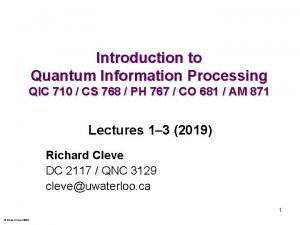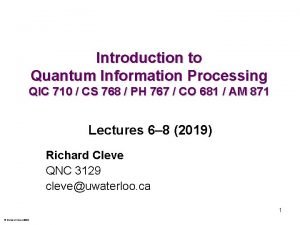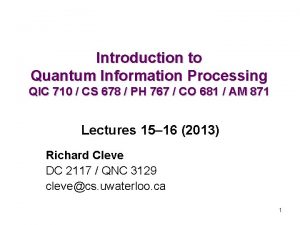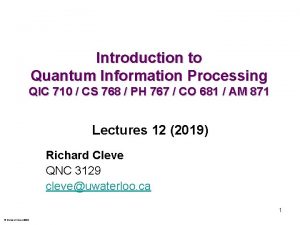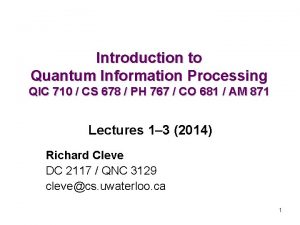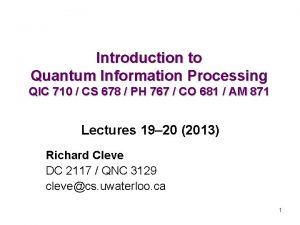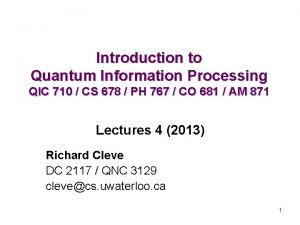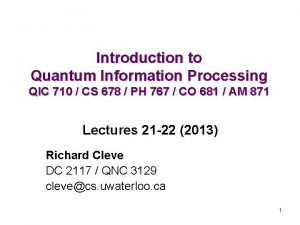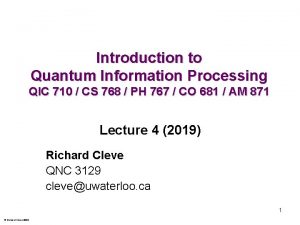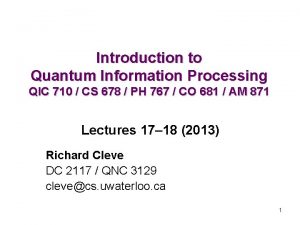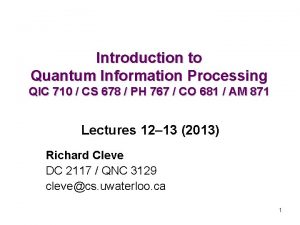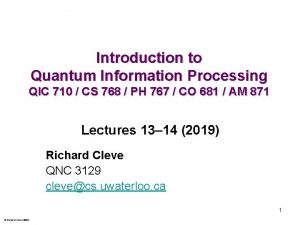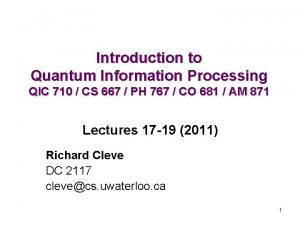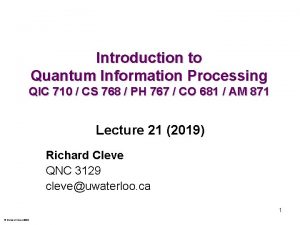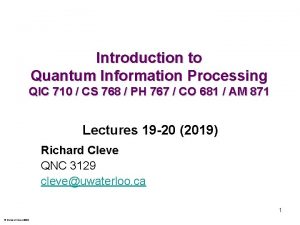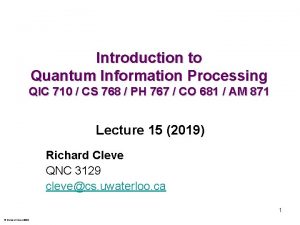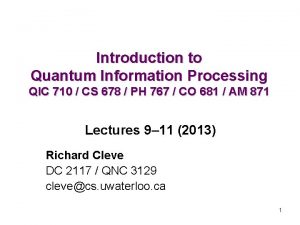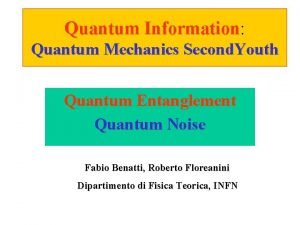Introduction to Quantum Information Processing QIC 710 CS


![Classical communication complexity [Yao, 1979] x 1 x 2 xn y 1 y 2 Classical communication complexity [Yao, 1979] x 1 x 2 xn y 1 y 2](https://slidetodoc.com/presentation_image_h/1b36b15cdb254189f977cfb96dd88bfa/image-3.jpg)
























- Slides: 27

Introduction to Quantum Information Processing QIC 710 / CS 768 / PH 767 / CO 681 / AM 871 Lecture 22 -23 (2019) Richard Cleve QNC 3129 cleve@uwaterloo. ca 1 © Richard Cleve 2020

Communication complexity 2 © Richard Cleve 2020
![Classical communication complexity Yao 1979 x 1 x 2 xn y 1 y 2 Classical communication complexity [Yao, 1979] x 1 x 2 xn y 1 y 2](https://slidetodoc.com/presentation_image_h/1b36b15cdb254189f977cfb96dd88bfa/image-3.jpg)
Classical communication complexity [Yao, 1979] x 1 x 2 xn y 1 y 2 yn f (x, y) E. g. equality function: f (x, y) = 1 if x = y, and 0 if x y Question: can the communication be less than n bits? 3 © Richard Cleve 2020

Deterministic cost is n bits (I) Suppose the communication complexity of f is k f (x, y) : Table of all values of 000 001 010 011 100 101 110 111 000 1 0 0 0 001 0 0 0 0 010 0 0 1 0 0 011 0 0 0 0 100 0 0 1 0 0 0 C {0, 1}k+1 101 0 0 0 1 0 0 (k+1 -bit conversation) 110 0 0 0 1 0 111 0 0 0 0 1 Definition: A (combinatorial) rectangle is R {0, 1}n of the form R = RA RB © Richard Cleve 2020 Each input in the domain of f fixes a conversation (including output) output Several inputs may lead to the same conversation. . . 4

Deterministic cost is n bits (II) f (x, y) : Table of all values of 000 001 010 011 100 101 110 111 000 1 0 0 0 001 0 0 0 0 010 0 0 1 0 0 011 0 0 0 0 100 0 0 101 0 0 0 110 0 0 0 1 0 111 0 0 0 0 1 In fact, the inputs leading to C must constitute a rectangle: if (x, y), (x', y') both lead to C then so do (x', y) and (x, y') Since each conversation has a unique output, f is constant on each of these rectangles Need at least 2 n+1 rectangles to {0, 1}-partition this table Since this implies 2 n+1 distinct conversations, k n Therefore, the deterministic communication complexity is n © Richard Cleve 2020 5

Probabilistic cost is O(log n) bits Start with a “good” classical error-correcting code, which is a function {0, 1}n {0, 1}cn such that, for all x ≠ y, Δ(e(x), e( y)) δcn where e: (Δ means Hamming distance), c, δ are constants x 1 x 2 xn randomly choose r {1, 2, . . . , cn} (r, e(x) ) r y 1 y 2 yn output 1 if e( y)r = e(x)r 0 if e( y)r e(x)r e(x) = 1 0 1 1 1 0 0 1 e(y) = 0 1 1 0 0 1 0 Can repeat to reduce error © Richard Cleve 2020 random k 6

Quantum communication complexity x 1 x 2 xn y 1 y 2 yn Qubit communication qubits Prior entanglement x 1 x 2 xn entangled qubits f (x, y) y 1 y 2 yn f (x, y) Question: can quantum beat classical in either of these this contexts? 7 © Richard Cleve 2020

Appointment scheduling (also known as the Disjointness Problem) 1 2 3 4 5 . . . n x= 01101… 0 1 2 3 4 5 . . . n y= 10011… 1 i (xi = yi = 1) Classically, (n) bits necessary to succeed with prob. 3/4 For all > 0, O(n 1/2 log n) qubits sufficient for error prob. < [KS ‘ 87] [BCW ‘ 98] © Richard Cleve 2020 8

Search problem 1 Given: 2 3 4 5 6 . . . n x= 000010… 1 log n i 1 b x accessible via queries i bb xxii Goal: find i {1, 2, …, n} such that xi = 1 Classically: (n) queries are necessary Quantum mechanically: O(n 1/2) queries are sufficient [Grover, 1996] © Richard Cleve 2020 9

1 2 3 4 5 6 . . . n Alice x= 011010… 0 Bob y= 100110… 1 x y = 0 0 1 0 … 0 i x y 0 0 b i y x x y 0 0 b Bob Communication per x y-query: 2(log © Richard Cleve 2020 (bitwise AND of x and y) Alice n + 3) = O(log n) Bob 10

Appointment scheduling: epilogue Bit communication: Cost: θ( n) Bit communication & prior entanglement: Cost: θ( n 1/2) [R ‘ 02] [AA ‘ 03] © Richard Cleve 2020 Qubit communication: Cost: θ( n 1/2 ) (with refinements) Qubit communication & prior entanglement: Cost: θ( n 1/2) 11

Quantum fingerprinting 12 © Richard Cleve 2020

Equality revisited in simultaneous message model x 1 x 2 xn y 1 y 2 yn f (x, y) Equality function: f (x, y) = 1 if x = y 0 if x y Exact protocols: require 2 n bits communication 13 © Richard Cleve 2020

Equality revisited in simultaneous message model x 1 x 2 xn 1 2 y 1 y 2 yn . . . 1 classically correlated 2 . . . classically correlated f (x, y) Pr[00] = Pr[11] = ½ Bounded-error protocols with a shared random key: require only O(1) bits communication Error-correcting code: e(x) = 1 0 1 1 0 0 1 e(y) = 0 1 1 0 0 1 0 1 0 random k © Richard Cleve 2020 14

Equality revisited in simultaneous message model x 1 x 2 xn y 1 y 2 yn j e(y) = 11 11 10 10 01 00 e(x) = 01 10 01 11 11 01 i 011011 110101 001001 101111 f (x, y) 01001110 110101 101101 Bounded-error protocols without a shared key: Classical: θ(n 1/2) Quantum: θ(log n) using “quantum fingerprints” [A ‘ 96] [NS ‘ 96] [BCWW ‘ 01] © Richard Cleve 2020 15

Quantum fingerprints Question 1: how many orthogonal states in m qubits? Answer: 2 m Let be an arbitrarily small positive constant Question 2: how many almost orthogonal* states in m qubits? (* where | x y | ≤ ) am Answer: 22 , for some constant 0 a 1 Construction of almost orthogonal states: states start with a special classical error-correcting code, which is a function e : {0, 1}n {0, 1}cn such that, for all x ≠ y, δcn ≤ Δ(e(x), e(y)) ≤ (1− δ )cn (c, δ are constants) 16 © Richard Cleve 2020

Construction of almost orthogonal states for each x {0, 1}n (log(cn) qubits) Set x Then x y Since δcn ≤ Δ(e(x), e(y)) ≤ (1− δ )cn, we have | x y | ≤ 1− 2δ By duplicating each state, x x … x , the pairwise inner products can be made arbitrarily small: (1− 2δ )r ≤ Result: m = r log(cn) qubits storing 2 n = 2(1/c)2 (as opposed to n qubits!) © Richard Cleve 2020 m/r different states 17

What are these almost orthogonal states good for? Question 3: can they be used to somehow store n bits using only O(log n) qubits? Answer: No — recall that Holevo’s theorem forbids this Here’s what we can do: given two states from an almost orthogonal set, we can distinguish between these two cases: • they’re both the same state • they’re almost orthogonal Question 4: How? 18 © Richard Cleve 2020

Quantum fingerprints Let 000 , 001 , …, 111 be 2 n states on O(log n) qubits such that | x y | ≤ for all x ≠ y Given x y , one can check if x = 0 x y H H y or x ≠ y as follows: if x = y, Pr[output = 0] = 1 if x ≠ y, Pr[output = 0] = (1+ 2)/2 S W A P Intuition: 0 x y + 1 y x Note: error probability can be reduced to ((1+ 2)/2)r 19 © Richard Cleve 2020

Equality revisited in simultaneous message model x 1 x 2 xn Bounded-error protocols without a shared key: y 1 y 2 yn f (x, y) Classical: θ(n 1/2) Quantum: θ(log n) [A ‘ 96] [NS ‘ 96] [BCWW ‘ 01] © Richard Cleve 2020 20

Quantum protocol for equality in simultaneous message model x 1 x 2 xn y 1 y 2 yn x y Orthogonality test Recall that, with a shared key, the problem is easy classically. . . This quantum protocol only requires θ(log n) qubits © Richard Cleve 2020 21

Inner product 22 © Richard Cleve 2020

Inner product function x 1 x 2 xn y 1 y 2 yn f (x, y) = x・y = x 1 y 1 + x 2 y 2 + + xn yn mod 2 23 © Richard Cleve 2020

Aside: Bernstein-Vazirani problem I Let f (x 1, x 2, …, xn) = a 1 x 1 + a 2 x 2 + + an xn mod 2 Given: x 1 x 2 xn b Goal: determine a 1, a 2 , f x 1 x 2 with unknown a 1, a 2 , …, an xn b f (x 1, x 2, …, xn) …, an Classically, n queries are necessary 24 © Richard Cleve 2020

Aside: Bernstein-Vazirani problem II Let f (x 1, x 2, …, xn) = a 1 x 1 + a 2 x 2 + + an xn mod 2 Given: 0 0 0 1 H H H Goal: determine a 1, a 2 , f H H H a 1 a 2 an 1 …, an Classically, n queries are necessary Quantum mechanically, 1 query is sufficient 25 © Richard Cleve 2020

Lower bound for inner product I x・y = x 1 y 1 + x 2 y 2 + + xn yn mod 2 Proof: x 1 x 2 xn y 1 y 2 yn z Alice and Bob’s IP protocol inverted x 1 x 2 xn like a query to the BV problem with coefficients x 1, x 2, …, xn y 1 y 2 yn z (x・y) 26 © Richard Cleve 2020

Lower bound for inner product II x・y = x 1 y 1 + x 2 y 2 + + xn yn mod 2 Proof: x 1 x 2 xn 0 0 0 1 H H Alice and Bob’s IP protocol BV algorithm Alice and Bob’s IP protocol inverted x 1 x 2 xn H H H x 1 x 2 xn H 1 Since n bits are conveyed from Alice to Bob, n qubits communication necessary (by Holevo’s Theorem) © Richard Cleve 2020 27
 Qic 710
Qic 710 Qic 710
Qic 710 Qic 710
Qic 710 Qic 710
Qic 710 Quantum physics vs mechanics
Quantum physics vs mechanics Quantum physics vs quantum mechanics
Quantum physics vs quantum mechanics How to fill out a 3161
How to fill out a 3161 Vde 0100 teil 701
Vde 0100 teil 701 En yakın onluğa ve yüzlüğe yuvarlama
En yakın onluğa ve yüzlüğe yuvarlama Ortec 710
Ortec 710 A gas has a pressure of 710 kpa at 227
A gas has a pressure of 710 kpa at 227 Variable on both sides word problems
Variable on both sides word problems Opwekking 573 tekst
Opwekking 573 tekst Ar 710-2-2
Ar 710-2-2 Euperlan green
Euperlan green Quantum information stephen barnett solutions
Quantum information stephen barnett solutions Introduction to quantum statistical mechanics
Introduction to quantum statistical mechanics Top-down processing
Top-down processing Gloria suarez
Gloria suarez Bottom-up processing example
Bottom-up processing example Unsharp masking matlab
Unsharp masking matlab What is secondary processing of food
What is secondary processing of food Image enhancement point processing techniques
Image enhancement point processing techniques Histogram processing in digital image processing
Histogram processing in digital image processing Parallel processing vs concurrent processing
Parallel processing vs concurrent processing A generalization of unsharp masking is
A generalization of unsharp masking is Image processing
Image processing Morphological
Morphological
